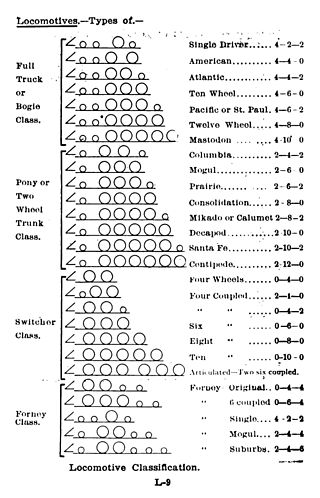
The Whyte notation is a classification method for steam locomotives, and some internal combustion locomotives and electric locomotives, by wheel arrangement. It was devised by Frederick Methvan Whyte, and came into use in the early twentieth century following a December 1900 editorial in American Engineer and Railroad Journal.
The UIC classification of locomotive axle arrangements, sometimes known as the German classification or German system, describes the wheel arrangement of locomotives, multiple units and trams. It is used in much of the world, notable exceptions being the United Kingdom, which uses a slightly simplified form of UIC, and in North America, where the AAR wheel arrangement system is used to describe diesel and electric locomotives. In North America, the Whyte notation is only used for steam locomotives.
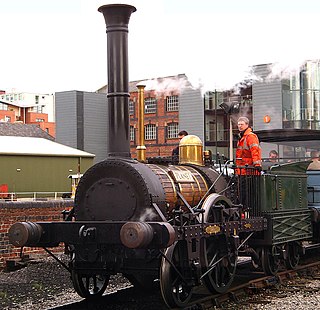
Under the Whyte notation for the classification of steam locomotives, 2-2-0 represents the wheel arrangement of two leading wheels on one axle, two powered driving wheels on one axle, and no trailing wheels. This configuration, which became very popular during the 1830s, was commonly called the Planet type after the first locomotive, Robert Stephenson's Planet of 1830.
Under the Whyte notation for the classification of steam locomotives, 0-10-2 represents the wheel arrangement of no leading wheels, ten powered and coupled driving wheels on five axles, and two trailing wheels on one axle.

In the Whyte notation for the classification of steam locomotives by wheel arrangement, a 2-8-8-0 is a locomotive with a two-wheel leading truck, two sets of eight driving wheels, and no trailing truck.

Under the Whyte notation for the classification of steam locomotives by wheel arrangement, 2-4-4 is a steam locomotive with two unpowered leading wheels followed by four powered driving wheels and four unpowered trailing wheels. This configuration was only used for tank locomotives; no tender locomotives with this wheel arrangement were made.
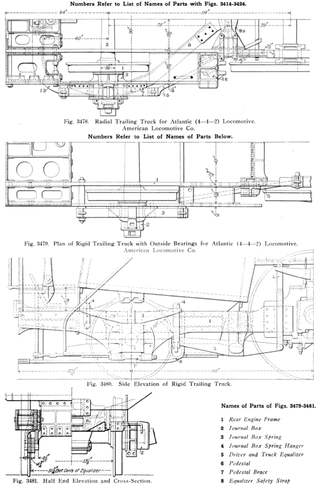
On a steam locomotive, a trailing wheel or trailing axle is generally an unpowered wheel or axle (wheelset) located behind the driving wheels. The axle of the trailing wheels is usually located in a trailing truck. On some large locomotives, a booster engine was mounted on the trailing truck to provide extra tractive effort when starting a heavy train and at low speeds on gradients.
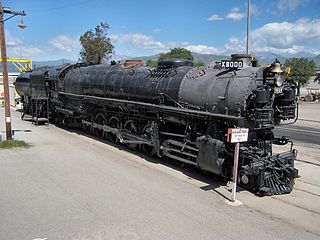
The Union Pacific Railroad 9000 Class was a class of 88 steam locomotives, built by ALCO for the Union Pacific between 1926 and 1930.
Under the Whyte notation for the classification of steam locomotives, 0-8-2 represents the wheel arrangement of no leading wheels, eight powered and coupled driving wheels on four axles, and two trailing wheels on one axle.

Under the Whyte notation for the classification of steam locomotives, 0-4-4 represents the wheel arrangement of no leading wheels, four powered and coupled driving wheels on two axles, and four trailing wheels on two axles. This type was only used for tank locomotives.
Under the Whyte notation for the classification of steam locomotives, 0-12-0 represents the wheel arrangement of no leading wheels, twelve powered and coupled driving wheels on six axles, and no trailing wheels.

Under the Whyte notation for the classification of steam locomotives, 2-12-0 represents the wheel arrangement of two leading wheels on one axle, twelve powered and coupled driving wheels on six axles, and no trailing wheels.
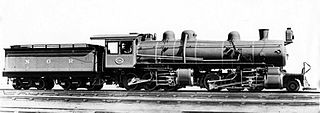
Under the Whyte notation for the classification of steam locomotives by wheel arrangement, 2-6-6-0 is a locomotive with one pair of unpowered leading wheels, followed by two sets of three pairs of powered driving wheels and no trailing wheels. The wheel arrangement was principally used on Mallet-type articulated locomotives. Some tank locomotive examples were also built, for which various suffixes to indicate the type of tank would be added to the wheel arrangement, for example 2-6-6-0T for an engine with side-tanks.

In Whyte notation for the classification of steam locomotives by wheel arrangement, an 0-4-4-2 is a locomotive that has no leading wheels, two sets of four driving wheels and two trailing wheels.
B-B and Bo-Bo are the Association of American Railroads (AAR) and British classifications of wheel arrangement for railway locomotives with four axles in two individual bogies. They are equivalent to the B′B′ and Bo′Bo′ classifications in the UIC system. The arrangement of two, two-axled, bogies is a common wheel arrangement for modern electric and diesel locomotives.
In Whyte notation, a 4-6-6-2 is a steam locomotive with four leading wheels in an unpowered bogie at the front of the locomotive followed by two sets of driving wheels with six wheels each, followed by two unpowered trailing wheels at the rear of the locomotive.

Under the Whyte notation for the classification of steam locomotives, 0-8-4 represents the wheel arrangement of no leading wheels, eight powered and coupled driving wheels on four axles, and four trailing wheels on two axles.
An 0-8-6, in the Whyte notation for the classification of steam locomotives by wheel arrangement, is a locomotive with no leading wheels, eight driving wheels fixed in a rigid frame, and six trailing wheels. All locomotives using this wheel arrangement were tank locomotives.
An 0-4-6T, in the Whyte notation for the classification of steam locomotives by wheel arrangement, is a locomotive with no leading wheels, four driving wheels fixed in a rigid frame, and six trailing wheels. Examples of this type of locomotive were built by Wilhelm von Engerth.
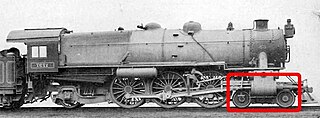
The leading wheel or leading axle or pilot wheel of a steam locomotive is an unpowered wheel or axle located in front of the driving wheels. The axle or axles of the leading wheels are normally located on a leading truck. Leading wheels are used to help the locomotive negotiate curves and to support the front portion of the boiler.












